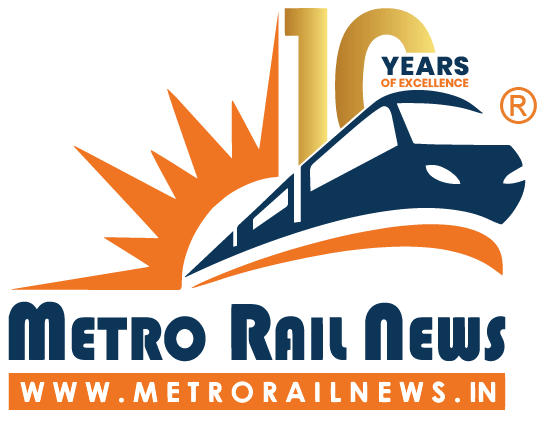Metro Rail News had the privilege to conduct an interview with Shri Shalabh Goel, Managing Director of NCRTC. Throughout the interview, Shri Shalabh Goel discussed the potential of India’s first RRTS Corridor to streamline connectivity in the NCR Region. Here are the edited excerpts.
The urban mobility landscape in the country is witnessing a paradigm shift with the commissioning of the Delhi-Ghaziabad-Meerut Namo Bharat corridor in the National Capital Region (NCR). Namo Bharat, a regional rapid transit system, is a new-age transport system, designed to revolutionise regional commutes by connecting cities across NCR with high-speed, sustainable, and commuter-friendly rail services. The Hon’ble Prime Minister inaugurated the 17 km long Priority Section of this corridor on 20th October 2023, and since then 55 km of this 82 km long corridor with 11 stations has become operational in a phased manner.
The project, being implemented by the National Capital Region Transport Corporation (NCRTC), has been meticulously conceptualised to address the socio–economic aspirations of the people of NCR, empowering them with enhanced access to education, healthcare, employment, affordable housing and broader economic opportunities.
Q1) Can you share some key details with our readers about the need for this first-of-its-kind project, i.e. Namo Bharat?
The National Capital Region (NCR) is one of the most densely populated regions in the world. People, driven by the promise of economic opportunities and a better quality of life, continue to flock to the area at a pace that shows no signs of slowing down. However, this rapid population growth is placing immense pressure on the region’s infrastructure, threatening its sustainability and balanced development. NCR now also faces some of the most hazardous air quality levels globally, with one of the major contributors being the millions of private vehicles that operate throughout the region.
Further compounding the issue are the severe traffic bottlenecks that affect critical interconnecting routes. Whether commuting from Gurgaon to Greater Noida or from Meerut and Ghaziabad to Delhi Airport, the lack of adequate public transport creates a vicious cycle, wherein reliance on private vehicles persists, aggravating the region’s congestion and pollution problems.
In response to these urgent challenges, the need for a comprehensive, affordable, and efficient modern urban regional public transport system has become increasingly critical. Such a system is not only essential for alleviating current issues but also for ensuring seamless connectivity, meeting the growing demand for mobility, and fostering sustainable urban development. Given the scale and capital-intensive nature of the project, it is crucial that the system not only meets the needs of today but is also designed to evolve and accommodate future challenges, including population growth, urban expansion, technological advancements, and long-term feasibility.
The Namo Bharat project was conceived as a strategic solution to address the pressing transportation and environmental issues confronting NCR. It is part of the ‘Comprehensive Action Plan (CAP) for Air Pollution Control in Delhi & NCR’ and aligns with the recommendations of the ‘High Powered Committee on Decongesting Traffic in Delhi’.
Q2) In the backdrop of the Environment Day being observed across the globe, can you highlight the Sustainability and Environmental Initiatives being taken by NCRTC?
Sustainability is at the core of the Namo Bharat project, with a focus on creating a cleaner and greener transportation system. As a rail-based transit system, Namo Bharat uses electric traction, significantly reducing fossil fuel consumption compared to traditional road vehicles. This shift contributes directly to a reduction in air pollution and supports the region’s broader environmental goals.
The implementation of the Delhi-Meerut Namo Bharat corridor is expected to substantially increase the share of public transportation usage along the route, from 37% to 63%. Once fully operational, the first Namo Bharat corridor will help take-off over one lakh private vehicles from the roads, leading to an estimated reduction of approximately 2,50,000 tonnes of carbon dioxide emissions annually. This impact is a significant step towards reducing NCR’s carbon footprint and improving the region’s air quality.
NCRTC remains committed to minimizing the environmental impact of the project through the adoption of numerous eco-friendly technologies and green initiatives. One such initiative is the state-of-the-art regenerative braking system integrated into the Namo Bharat rolling stock. This technology captures the train’s kinetic energy and converts it into electrical energy, achieving an energy saving of up to 30%.
In alignment with India’s National Solar Mission and the promotion of renewable energy, NCRTC introduced a solar policy in March 2021. As part of this policy, NCRTC aims to generate approximately 11 MW of peak solar power from rooftops of stations, depots, and other buildings, primarily for non-traction purposes. To date, solar power plants with a capacity of 5 MW have already been commissioned, and the goal is to transform stations, depots, and substations into clean energy hubs.
In addition to offering a sustainable transit solution, NCRTC is also making significant efforts to promote a greener environment across the region. By incorporating rainwater harvesting structures and recharge pits into the design of stations, depots, and along the viaducts, the project contributes to local water conservation. This approach not only helps replenish the groundwater table but also supports the region’s long-term environmental sustainability at a relatively low cost.
Q3) What role does seamless multi-modal integration play in promoting the use of public transit systems?
The success of any public transport system relies on its acceptability among the people and their willingness to choose it over private vehicles. This can only be achieved when the implementing agency prioritises not only comfort, reliability, and safety but also seamless connectivity and universal accessibility. Recognising this, NCRTC made it a cornerstone of the Namo Bharat project from the outset, placing unprecedented emphasis on Multi-Modal Integration and Interoperability.
To enable modal shift in favour of public transport, strategically located Namo Bharat stations provide seamless connectivity with other modes of transport, including bus terminals, railway stations, airports, and metro stations. This ensures smooth interchanges for commuters, making the transition between different modes of transport easy and efficient.
This approach is also in line with the Hon’ble Prime Minister’s National Gati Shakti Masterplan. By enabling smooth transfers between modes, NCRTC seeks to provide a comprehensive solution to the growing mobility challenges faced by urban centres in the country. To facilitate this, we are working to ensure easy access to stations through walkways, lifts, escalators, foot over-bridges, and underpasses, facilitating universal access for all passengers.
In another significant development, Meerut Metro services will be provided on a 23 km stretch, utilising the infrastructure of the Namo Bharat corridor. This integration will allow commuters to travel the distance in just 30 minutes, offering an efficient and seamless transit experience. By leveraging the Namo Bharat infrastructure, this first-of-its-kind integration in the country will enhance mobility in Western Uttar Pradesh, providing a more streamlined and convenient travel option for daily commuters.
Furthermore, the Functional Plan for Transportation in NCR for 2032 identifies eight Namo Bharat corridors. Of these, three have been prioritised for Phase I implementation: the Delhi Ghaziabad-Meerut, Delhi-Gurugram-SNB-Alwar, and Delhi-Panipat-Karnal corridors. These three corridors will converge at Sarai Kale Khan Station, where they will be fully interoperable.
Interoperability will allow Namo Bharat trains to seamlessly travel from one corridor to another. For example, a train traveling from Panipat or Karnal can continue directly to Ghaziabad, Meerut, or Gurugram/SNB without the need for passengers to switch trains, saving them time, ensuring comfort, and eliminating any additional charges for the interchange.
The integration of these mass transit systems will create a vast network-of-networks, leading to higher ridership and ensuring long-term sustainability for these capital-intensive projects. This approach not only addresses the immediate mobility needs of the region but also sets the stage for a resilient and efficient public transportation infrastructure in the future.
Q4) With India becoming a ‘Digital First’ market, what steps has NCRTC taken for offering a Unified Ticketing System for the convenience of commuters?
In addition to prioritising the physical integration of various modes of transit, NCRTC has placed equal emphasis on Digital Integration. In line with the vision of “One India – One Ticket,” NCRTC has signed Memorandums of Understanding (MOUs) with Delhi Metro Rail Corporation (DMRC) to facilitate seamless ticketing for commuters. Through this collaboration, passengers can book tickets for both Namo Bharat and DMRC services using a single digital platform—either the Namo Bharat Connect App or the DMRC mobile app. A similar MOU has also been signed with the Indian Railway Catering and Tourism Corporation (IRCTC), further expanding the scope of digital integration. This unified ticketing system simplifies the travel experience, enabling commuters to easily access and navigate NCR’s vast transportation network.
Q5) In terms of technological innovations, in your view, which is the most critical achievement in the Namo Bharat project?
The Namo Bharat project integrates several cutting-edge technologies, making it one of the most advanced transport systems in the world. NCRTC has implemented the European Train Control System (ETCS) Level 2 over an LTE backbone, marking a global first. This system includes Automatic Train Protection (ATP) and Automatic Train Supervision (ATS), ensuring the highest standards of safety and efficiency for passengers. Additionally, Platform Screen Doors (PSDs) are integrated with the ETCS signalling system to prevent accidents and enhance passenger security.
Q6) Finally, as the excitement for the full Namo Bharat Dehi-Meerut corridor to be operational builds up, can you share the project status?
India’s first Namo Bharat corridor is being implemented between Delhi, Ghaziabad, and Meerut, covering an 82 km stretch. Recently, the Hon’ble Prime Minister inaugurated an additional 13 km extension between Sahibabad and New Ashok Nagar in Delhi, bringing the total operational stretch to 55 km, with 11 stations. With this inauguration, Delhi is now seamlessly connected to the historic city of Meerut, allowing commuters to travel the entire distance in just 35 minutes.
Key stations in Delhi, such as Anand Vihar and New Ashok Nagar, further enhanced connectivity and with integration with other transit modes expanded the reach widely. At present, the project is progressing steadily, with construction of the remaining sections underway, as per its scheduled timelines.
As the region continues to grow, Namo Bharat will be the bridge that connects communities, empowers commuters, and fosters a cleaner, more efficient environment. Through these efforts, the project is laying the foundation for a more connected, vibrant, and liveable NCR, where the quality of life is elevated for the benefit of all. Pic – Commuters at a Namo Bharat station.





